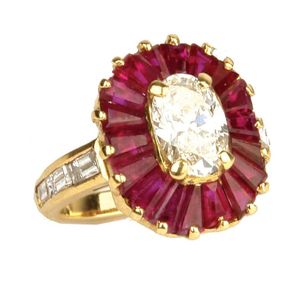Chamberlain Worcester Dragon Basket
You must be a subscriber, and be logged in to view price and dealer details.
Subscribe Now to view actual auction price for this item
When you subscribe, you have the option of setting the currency in which to display prices to $Au, $US, $NZ or Stg.
- Armorial / Armourial - Bearing a coat of arms. Coats of arms came into general use by feudal lords and knights in in the 12th century, and by the 13th century, arms had spread beyond their initial battlefield use to become a flag or emblem for families in the higher social classes of Europe. They were inherited from one generation to the next. When a family crest is used on individual items of silver or furniture it is an indicator of the aristocratic standing of the family represented.
Armorials were also used to decorate mass produced ceramic souvenir ware by such companies as Goss, Carlton & Shelley, and in these cases the coats of arms displayed were of boroughs and cities. - Heraldic Decoration - Heraldic decoration on silver, glass, and porcelain refers to the use of coats of arms and other heraldic symbols as decorative motifs on these materials. Coats of arms were traditionally used to identify individuals, families, and institutions, and were often displayed on shields, banners, and other objects.
The heraldic decoration typically takes the form of engraved or etched designs that incorporate coats of arms or other heraldic symbols. Heraldic decoration on silver, glass, and porcelain has a long history, dating back to the medieval period when coats of arms were first used. During the Renaissance and Baroque periods, heraldic decoration on decorative objects became increasingly elaborate and ornate, with finely detailed designs that often incorporated intricate scrollwork, mythological figures, and other decorative motifs.
In the 18th and 19th centuries, heraldic decoration became particularly popular among the aristocracy and upper classes, who used these objects as symbols of their wealth and status.
This item has been included into following indexes:
Visually similar items

A Royal Crown Derby plate from the wedding service of Prince George, Duke of York (later George V), and Mary of Teck, 1893, the ruffle edged plate finely gilt decorated with festoons, hearts and tooled borders on a coral pink border, centred with the entwi

An impressive 18ct. gold diamond and ruby cluster dress ring, the 1.00ct. oval modern brilliant cut diamond of 'Very Good Make', colour I and clarity VS2/SI1, claw set above a tapered encircling band of 18 tapered baguette rubies, each mounted with an oute

A ruby and diamond dress ring. 18ct yellow gold. Size L.

A beautiful antique ruby and diamond set brooch, 18ct yellow gold, made in a high Victorian style with brushed finish gold, marquise shaped with a central raised shaped plaque, inset with a five stone arrangement of alternating rubies and old cut diamonds,
